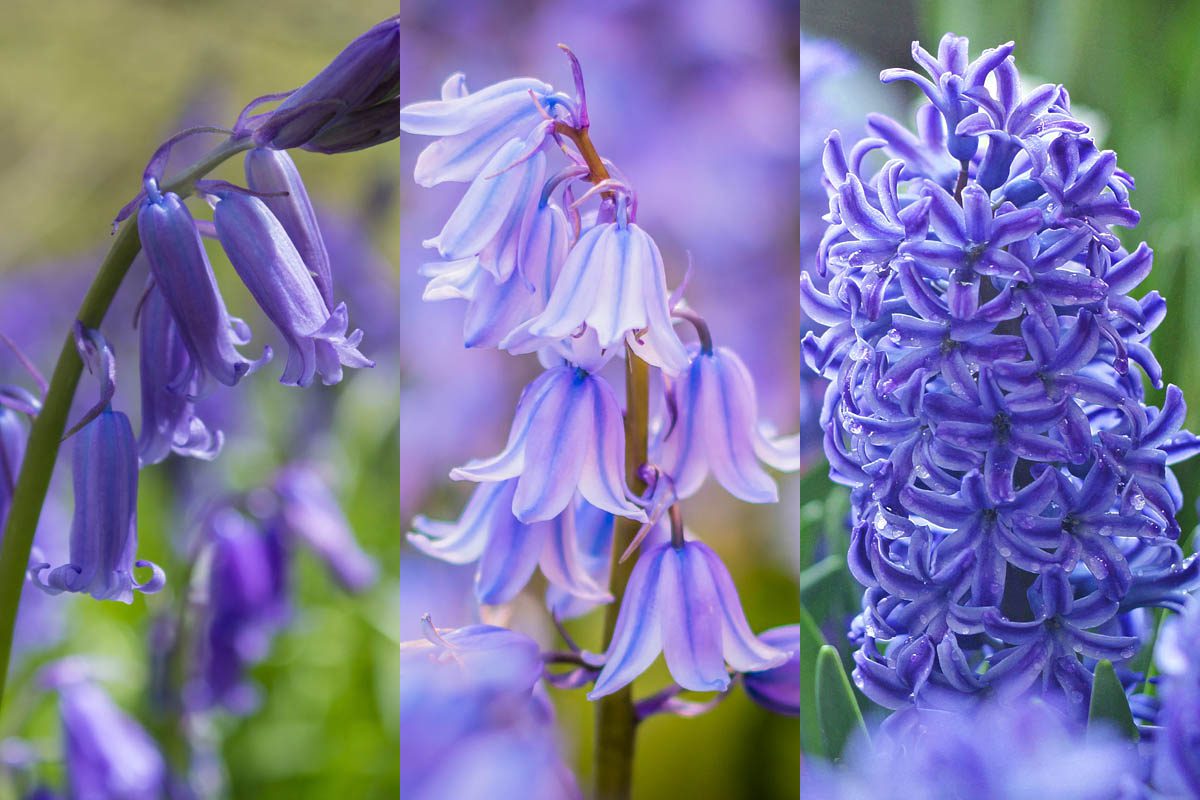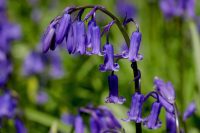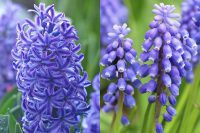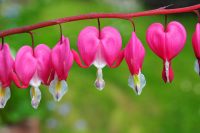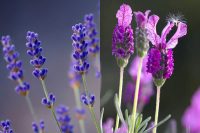Bluebells (Hyacinthoides non-scripta or Hyacinthoides hispanica) and hyacinths (Hyacinthus species) are subterranean bulbous perennials popular for their scented flowers that bloom in spring. All three species have, long, strapped leaves and bell-shaped flowers arranged on racemes. However, while bluebells and hyacinths share similarities, they are different species, which we will explore in this article.
English bluebells
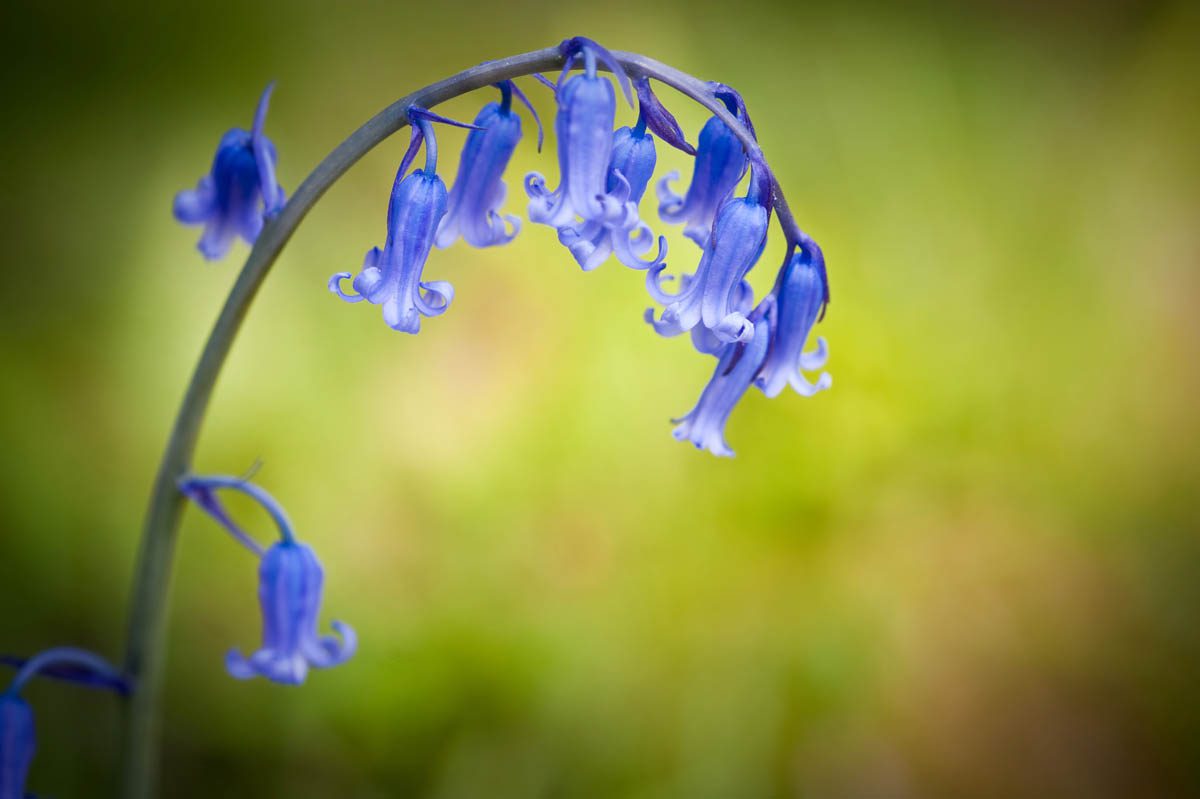
- Symbolism: Humility, constancy, gratitude and everlasting love.
- Uses: English bluebells are predominantly wildflowers. As a protected species, it is illegal to pick them.
English bluebells (Hyacinthoides non-scripta) are a bulbous perennial native to woodland areas of the United Kingdom. The English bluebell produces a carpet of highly scented deep blue flowers in spring. The tubular, bell-shaped flowers have a distinctive drooping appearance, which hangs down one side on the tall, slender stem.
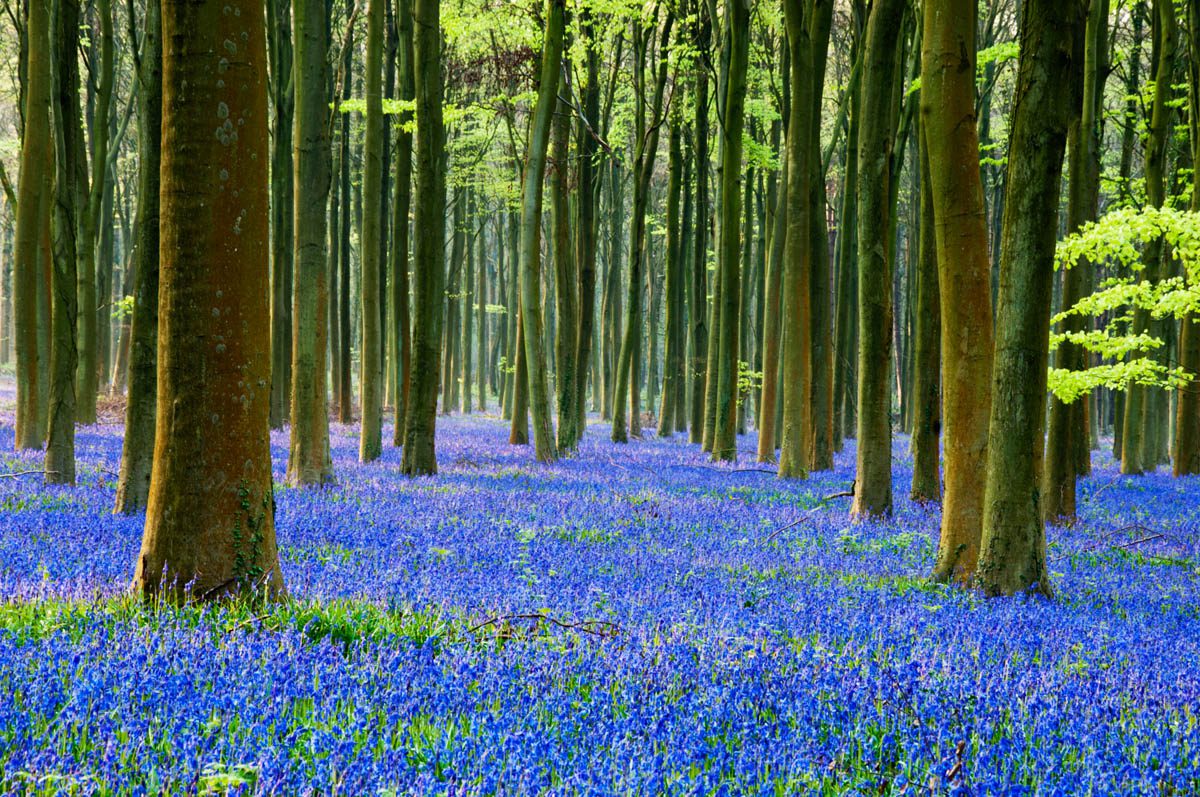
English bluebells indicate the ancientness of woodland, as they are slow to spread and are found in older-growth areas. Unfortunately, they are at risk due to the loss of woodland, which now accounts for only 13% of land area in the UK, as well as competition from Spanish bluebells and English x Spanish bluebell hybrids.
The term “bluebell” derives from the distinct shape and colour of the flower. The blossoms are bell-shaped and typically exhibit a rich, blue color.
Spanish bluebells
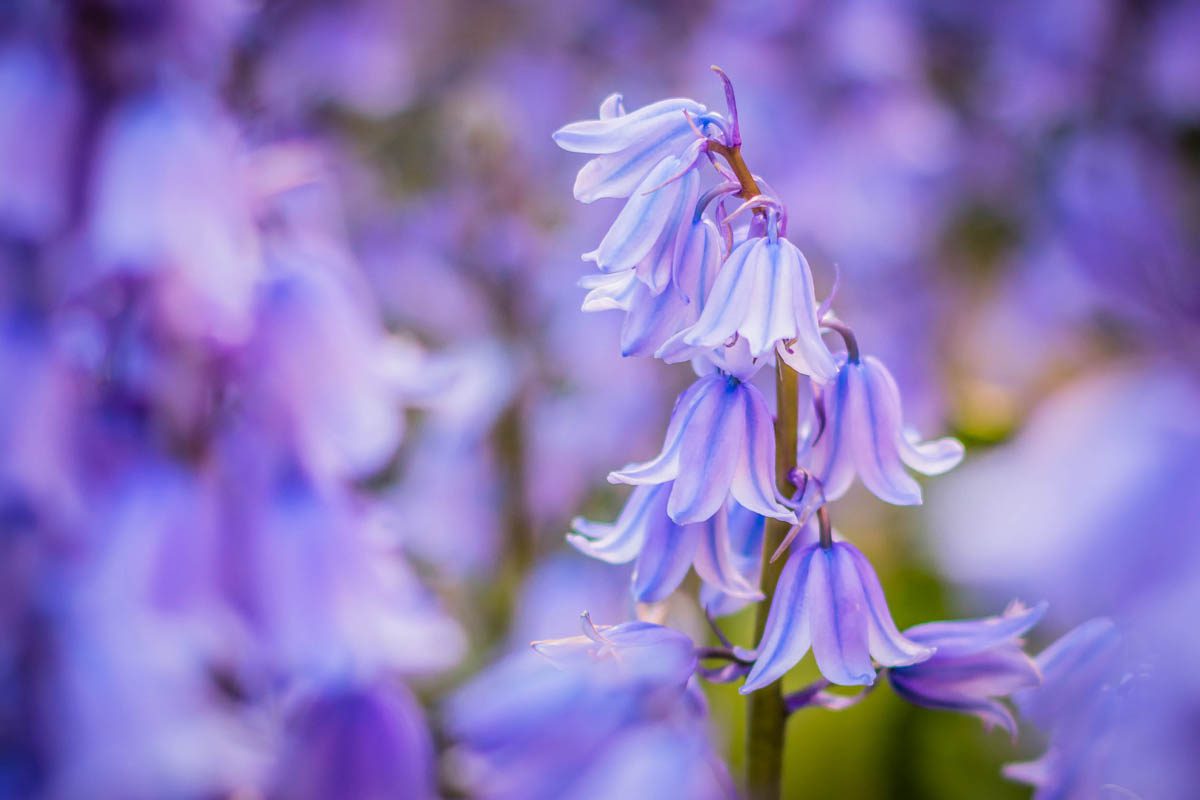
- Symbolism: Humility, constancy.
- Uses: Spanish bluebells are grown for ornamental purposes. They are not protected and can be picked.
Spanish bluebells (Hyacinthoides hispanica) are a bulbous perennial native to the Iberian Peninsula. The Spanish bluebell produces a pale pink, bell-shaped flower with a mild fragrance in spring. They were introduced to the United Kingdom in the 1700s as ornamental flowers, but have escaped into the wild.
The Royal Horticultural Society recommends against growing Spanish bluebells, particularly near areas where wild bluebells grow, as they can hybridise with English bluebells to produce Hyacinthoides x massartiana. This hybrid can outcompete the native English bluebell.
English and Spanish bluebells have evolved to fill similar ecological niches within their native habitats. This is an example of parallel evolution, where similar traits can evolve independently in species that are not closely related because they adapt to similar environments or ecological niches.
Hyacinth
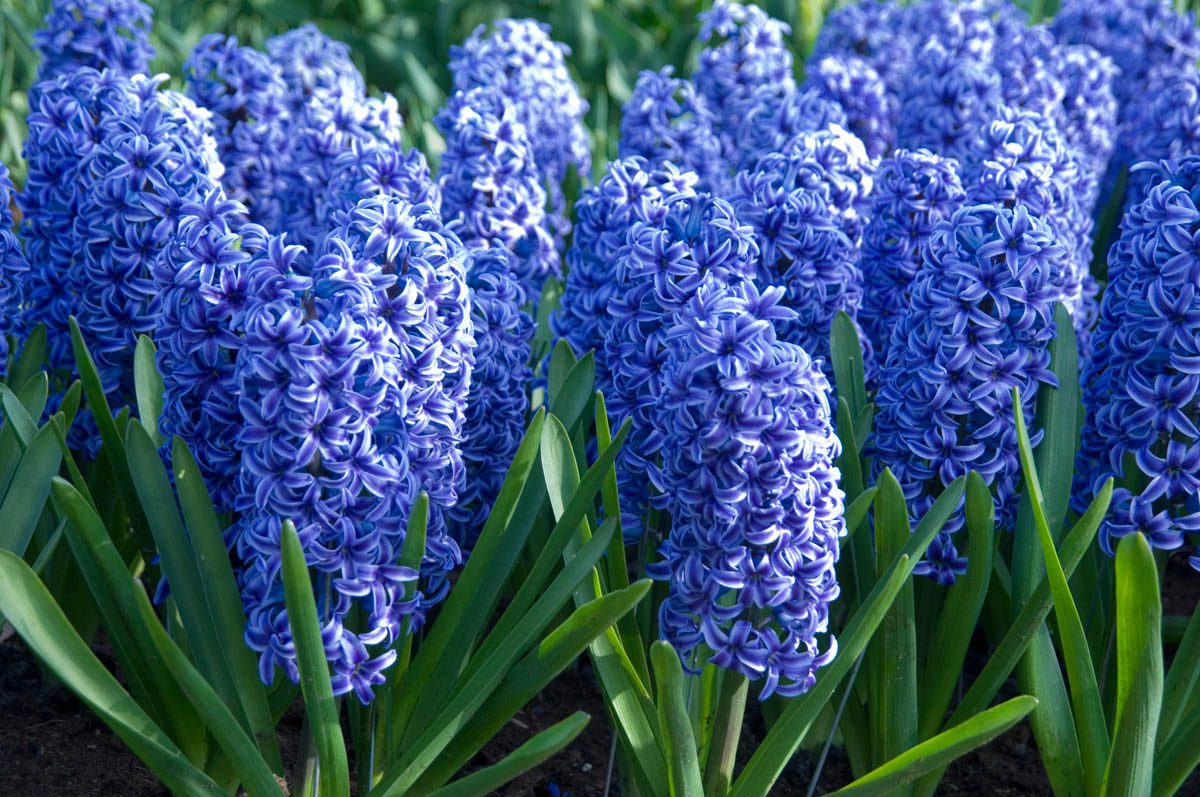
- Symbolism: Playfulness, loveliness, loyalty, friendship
- Uses: Cut flowers, indoor pot plant, outdoor pot plant, garden beds
Hyacinth (Hyacinthus orientalis) is a small genus of bulbous perennials native to the eastern Mediterranean, from the north of Bulgaria through to the northern part of the region of Palestine. Vibrant clusters of highly fragrant flowers bloom in early spring. The densely packed flowers grow along the stem in a conical or cylindrical shape and grow in a variety of colours including blue, white, pink, purple and yellow.
Hyacinths are commonly grown in decorative pots indoors or outdoors during their blooming period. They perform a spectacular display when grown in clusters.
The name hyacinth is from Greek mythology. Hyacinthos (Ὑακινθος) was a beautiful spartan prince loved by the god Apollo. While throwing a discus, Apollo accidentally hit Hyacinthos, killing him. A flower sprang up where Hyacinthos’s blood spilled, which Apollo named ‘hyacinth‘ in his honour.
Difference between English bluebells, Spanish bluebells and hyacinth
| English bluebell | Spanish bluebell | Hyacinth | |
| Scientific name | Hyacinthoides non-scripta | Hyacinthoides hispanica | Hyacinthus orientalis |
| Common names | Spanish hyacinth, wood hyacinth | Hyacinth, garden hyacinth, woodstock | |
| Native to | United Kingdom | Iberian Peninsula and Northwest Africa | Eastern Meditteranean |
| Flower shape | Drooping, long and tubular, curved at the end |
Short, and as wide as it is long | Tubular, bell-shaped |
| Flower colour | Blue, occasionally white | Blue, occasionally pink or white | Blue, pink, white |
| Flower arrangement | Flowers droop or nod to one side of the stem |
Flowers are arranged all around the stem |
Flowers are densely packed around the stem |
| Flowers | 6 separate, recurved petals | 6 separate, splayed petals | 6 petals fused into a tube |
| Leaves | Narrow and strap-shaped, slightly curved edges (0.7 – 1.6 cm wide) | Broad and strap-shaped, smooth edges, 2 – 4 cm wide | Broad, strap-like |
| Leaf arrangement | Alternate along the stem | Alternate along the stem | Basal rosette |
| Scent | Strong, sweet fragrance | Mild, sweet fragrance | Strong, sweet fragrance |
| Flowering time | Mid-spring | Mid-spring | Early to mid-spring |
| Use in cut flower arrangement | Not commonly used due to drooping habit (and protected) | More commonly used than English bluebells | Frequently used, highly fragrant |
| Soil pH preference | Slightly acidic to neutral | Slightly acidic to neutral | Neutral to slightly alkaline |
| Historical significance | Featured in folklore and many classic English poems |
Less cultural significance in the UK | Used in ancient Greek festivals; significant cultural symbol in the Netherlands |
| Cultural Significance | Icon of British woodlands, a symbol of spring | Often confused with English bluebells; less cultural symbolism |
Symbolises playfulness, sport in the language of flowers |
| Competitiveness | Can form dense colonies, outcompeting other undergrowth in woods |
Can be more invasive, and potentially problematic in certain areas | Not known for out-competing other plants |
| Bulb size | Medium | Medium | Large |
| Plant height | Taller, up to 45 cm (18 inches) | Up to 30 cm (12 inches) | Shorter, up to 30 cm (12 inches) |
| Habitat | Woodlands, meadows, hedgerows | Woodlands, meadows, scrubland, rocky hillsides | Open areas, hillsides and fields |
| Pollen colour | Cream | Blue, blue-green | Light yellow |
| Uses | Woodland gardens, shady borders | More sun-tolerant than English Bluebells, suited to borders and containers |
Beds, borders, containers, and indoor forcing |
| Growing conditions | Prefers moist, well-drained soil and partial to full shade | Tolerates a wider range of conditions, including full sun | Prefers well-drained soil and full sun or partial shade |
| Pollinators | Attracts bees, butterflies, and other insects | Attracts bees, butterflies, and other insects | Attracts bees, butterflies, and other insects |
| Hardiness zone | USDA Zones 4-5 | USDA Zones 4-9 | USDA Zones 4-9 |
| Conservation status | Protected in the UK | Not protected | Not protected |
Julia is a writer and landscape consultant from Wollongong with a love of horticulture. She had been an avid gardener for over 30 years, collects rare variegated plants and is a home orchardist. Julia is passionate about learning and sharing her knowledge of plant propagation and plant toxicology. Whether it’s giving advice on landscape projects or sharing tips on growing, Julia enjoys helping people make their gardens flourish.
